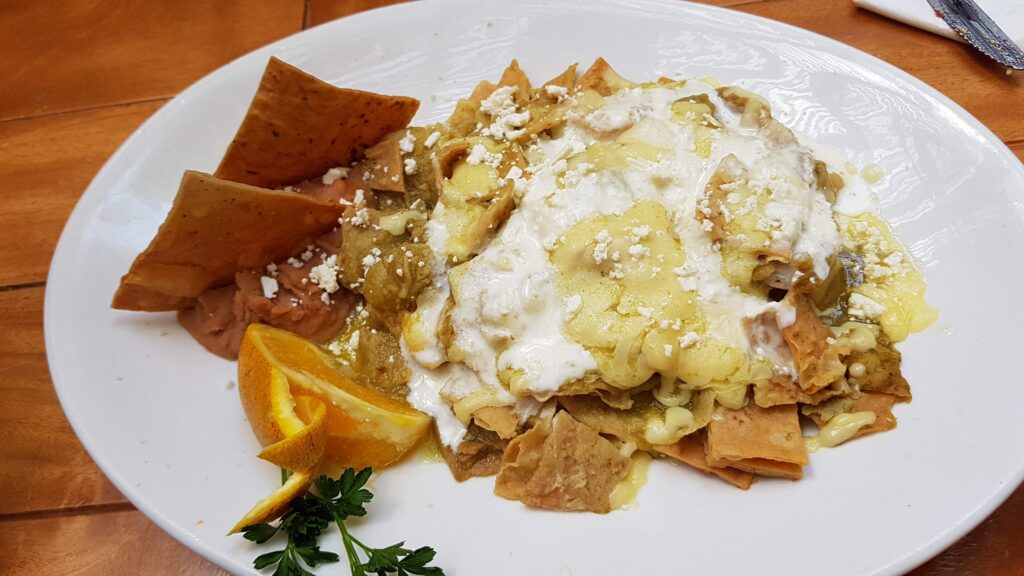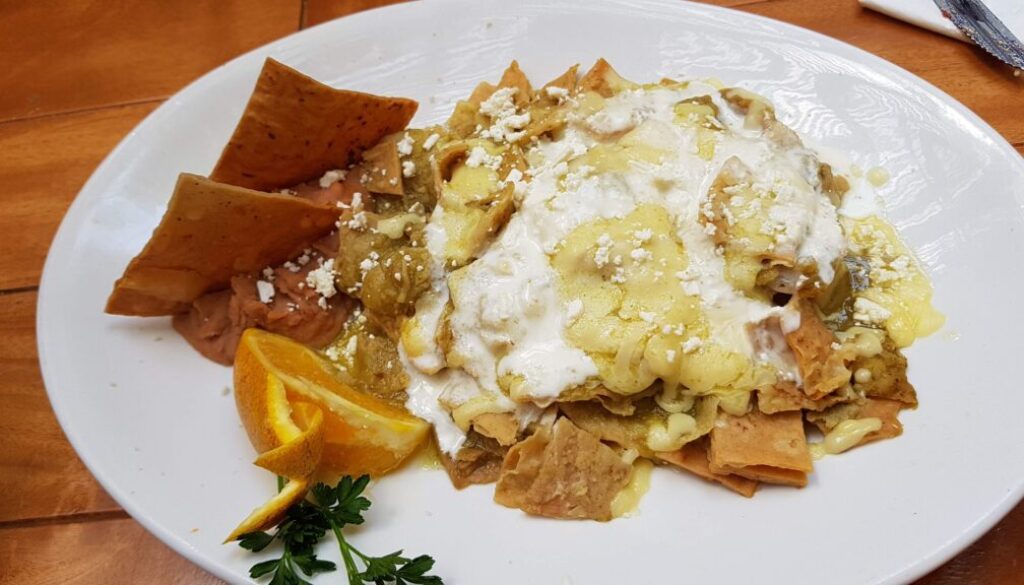The other day I was looking for a recipe for chilaquiles, a Mexican dish.
Living in the Netherlands, obviously the search results that popped up on my Google screen were results from Dutch websites, instead of original Mexican recipes.
This surprised me. I actually didn’t expect to see so many recipes in Dutch, as I thought the dish is still rather unknown here. It made me curious to see if they could actually describe how to make authentic chilaquiles. I expected to see authentic Mexican recipes, that were written because of a great food experience during a trip to México.
Unfortunately in reality it was anything but that, the recipes turned out to be covered in tex-mex influences. I was baffled to see yet another Mexican dish diminished to tex-mex crap.
And don’t get me wrong here.
Being Dutch, I also grew up believing a real Mexican taco is a hard taco shell, filled with minced meat, tomato, lettuce and salsa.
No, not the Spanish word for salsa, which could literally be any kind of salsa. Yes, even mayonesa is salsa – I think many ‘Mexican’ European restaurants would be pretty embarrassed if they would find out about their wrongful use of the word salsa. On this side of the world, salsa is known as a red sauce made of diced tomatoes, usually mixed with Mexican spices. The result tastes a little bit like ketchup. Or tomato soup. It depends on the non-Mexican chef.
And yes, my dear Mexican reader – if you’re out here – most Mexican restaurants in Europe are not owned by Mexicans. Most of them don’t even have a single clue about what authentic Mexican food looks like. Many of your paisanos have had the disappointment of their life when they were craving tacos with real Mexican salsa, and got served hard shell tacos with a ketchup-y sauce.
How to recognize a Mexican restaurant that does serve something more Mexican?
Check the ingredients of their dishes! If their tacos and burritos mainly have minced meat: skip that place. If you find things like salsa verde, mole, soft tortillas and real Mexican names for the guisos in your taco, you can definitely give it a try. It’s still no guarantee that the owner and/or his staff is Mexican though.
Heck, even when a Mexican restaurant is Mexican owned you have to be aware of their menu. In places where people believe Mexican food to be something different, it simply doesn’t always work in your benefit to serve 100% Mexican food. For sure, it will please every Mexican visitor. But the local people will probably get disappointed not to find their idea of real Mexican food on the menu.
It’s a dilemma. And It’s a tough one.
I find it very sad people worldwide have such a different idea of Mexican food, yet it’s one of the most popular foods out there. Many people would mention ‘Mexican food’ as their favorite kitchen.
But yeah.. which version of the Mexican cuisine?
My ex husband and I actually made a video about this difference. We served our friends a Dutch version of Mexican food, so a hard shell taco with minced meat. The recipe came out of a box that gets sold a lot in the supermarkets here, as Mexican tacos. To show them the real version of Mexican food, we prepared tacos al pastor, with homemade corn tortillas by the way.
First we asked them if they’ve already eaten Mexican food before – asking them to specify what and where.
Then, they tasted. First the Dutch version. It matched their expectations, for them this was Mexican food. Maybe not the tastiest they’ve had, but it was unmistakenably what they believe to be a Mexican meal.
Until they took a bite of the taco al pastor.
If you’d like to see the video, you can find it here.
Anyway, I’m spiralling way offtopic.
I understand and accept that many people worldwide have different ideas on Mexican food, tacos, burritos, quesadillas, enchiladas. Even nachos and chili con carne are always called Mexican food. It’s okay. People grew up with that version of Mexican food. And even though the name isn’t correct, it is still some type of cuisine and many people love it. Because it is actually is delicious! The combination of ingredients usually makes for a very good taste. Maybe not comparable to Mexican food, but if you’d see them as two entirely different kitchens – and can identify them – it’s pretty much okay.
How to recognize tex-mex dishes?
In many countries the Mexican spice mix contains cumin, chilli pepper, paprika etc etc. Their Mexican dishes have red tomato sauce, a glot of sour cream, cheese and often beans, corn, minced meat and bell pepper. When you see these ingredients, you often know you found some tex-mex version. You can still decide to walk away, or to enjoy a tex-mex meal. But don’t forget to throw all of your expectations on Mexican food over board.
For me the problem gets real when people start using names of real Mexican dishes and turn them into some tex-mex version. There is no way to be prepared for a culinary disaster when your expectations rise upon reading Mexican terms like mole and chilaquiles.
That’s what happened when I found the Dutch recipes of Chilaquiles. My first reaction was to be very happy to see – at least I hoped it to be – Dutch foodies spreading the word on authentic Mexican food.
My first thought was: this can’t be true!
And it wasn’t.
The recipes I found were just another version of nachos with toppings, while another one even looked more like a Mexican – sorry, texmex – versión of shakshuka.
Oh my poor non-Mexican heart!
People, why? Why would you write a recipe when you’ve never tasted the original dish? What makes people want to do this? Score points as being one of the first to write a Dutch recipe on a dish that is still fairly unknown here?
I felt a desire to report the recipes, but obviously that won’t change anything.
Then, someone pointed out to me that I could better put my energy into spreading the real recipe of chilaquiles. To show you what Chilaquiles really taste like. Because even though nachos and shakshuka are delicious, they can’t beat chilaquiles.
The real chilaquiles
Chilaquiles are delicious, the taste is something special. Every time someone shares pictures of Chilaquiles on Instagram, my cravings peak to an incredible height.
They are just so good! It’s the ultimate comfort food. Or power food, just like an English breakfast, a breakfast that will give you the power to handle absolutely anything. Like recovering from a hangover, for example.
Because yes, Chilaquiles is originally a breakfast meal. But don’t worry, you can eat it at any time of the day. The Mexican food gods won’t blame you at all. They might get really offended when you prepare the texmex version though. Just like all 126 millions of Mexicans will. So beware the next time you mention tex-mex dishes and authentic Mexican food in one sentence.
What are chilaquiles?
The name chilaquiles most probably comes from the language nahuatl (I say probably, because there are two different theories). It would mean ‘* put in chilli’, so in this case ‘totopos in chilli’.
It’s a very popular, yet simple dish, that is easy to prepare. The amount of calories in the dish is very high. Chilaquiles are a traditional breakfast – and apparantely a very popular one as many people order this meal at breakfast. In Mexico, breakfast is one of the most important meals of the day. That’s why you’ll often see them go big at breakfast.
There are different variations in different parts of the country, but usually you can pick from chilaquiles in salsa roja or salsa verde, the sauce depends on the chili peppers that were used. As mentioned before, the other main ingredient are totopos. Triangles of fried corn tortillas, which often can be kind of the same thing as bagged nacho chips. The totopos get bathed in the sauce of choice, this will soften the totopos. On top you’ll find cheese, cream and cilantro. The meal is already delicious like this, but it can also be accompanied by shredded chicken, arrachera steak, cecina, marinated meat or chorizo, with beans as a side dish.

The Recipe for Chilaquiles
Ingredients (for 2 persons):
- Totopos, a handful per person – you can cut corn tortillas in triangles, or use totopos or natural nacho chips from a bag
- Salsa verde or roja (in a jar or prepare it yourself with these recipes: salsa roja and salsa verde)
- 4 Eggs
- Shredded cheese
- 150 ml sour cream
- Optional: cilantro
- Optional: avocado (in slices)
Preparation:
- If you decided to make the sauce fresh, you can start from the point where the sauce is heating in the pan. If you’re using sauce out of a jar, you can pour it in a frying pan to heat it up.
- In case the sour cream you’re using is very thick, you can liquify it with a table spoon of vinegar and a table spoon of water.
- Add butter or oil to another frying pan and fry the eggs. I recommend to use two eggs per person, but you can also use one egg. If you’re planning on adding other kinds of meat, I recommend to go for one egg, as the dish is highly saturating.
- Are you making totopos from corn tortillas? Cut the tortillas in triangles, it doesn’t have to be a very neat job. Add oil to another frying pan and fry the tortilla bits during 5 minutes.
- In case you can’t find 100% corn tortillas, it is better to go with totopos or nacho chips from a bag. Take one handful for every person and add them to the sauce. Mix it a little bit, but don’t let it simmer. We want the totopos to stay nice and crunchy, leaving them too long in the pan will make them very mushy. Turn off the fire and serve the totopos with the sauce on a plate.
- Drizzle the sour cream on top of the tortillas and sprinkle the shredded cheese over it. If you like, you can add cilantro as well.
- Place the fried eggs on top of the chilaquiles. If you decided to add avocado or meats as ingredients you can place them on top or next to the chilaquiles on your plate. Refried beans are used as a side dish. Enjoy!



